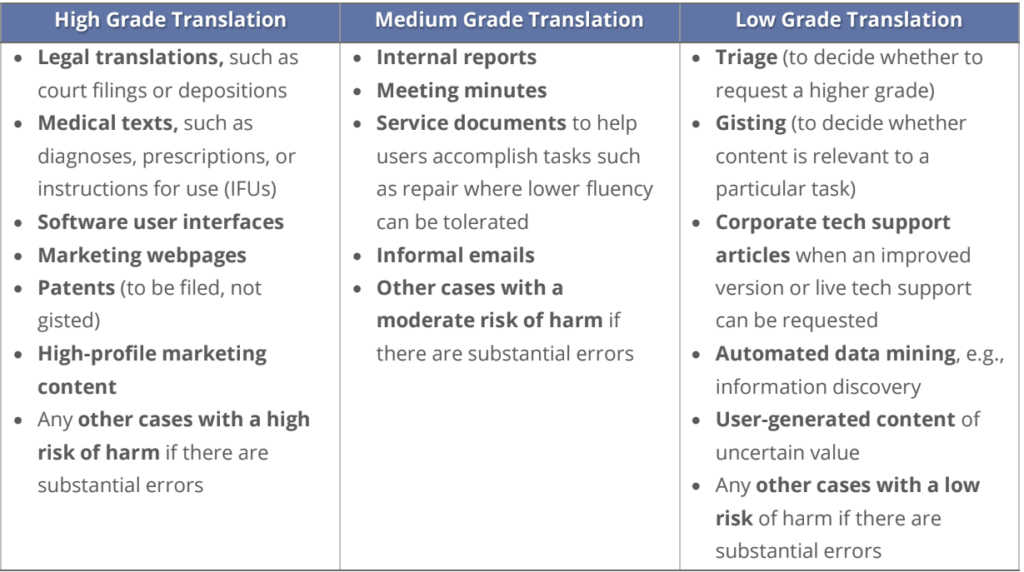A proposal has been made for establishing three grades of translation. These grades are defined based on varying levels of required correspondence and fluency.
Correspondence is the difference between the meaning understood from the target text and the meaning understood from the source text.
Fluency is how the target text compares to itself, such as number of grammatical or spelling errors or if the translation reads smoothly.
Once a tentative grade has been selected, a risk analysis must be performed. In the context of grades, risk is the amount damage to people, equipment, or reputation that is possible due to incorrect translations.
A use case at high levels of risk will need a high grade translation, which has high levels of required correspondence and fluency. A use case at low levels of risk find it acceptable to have a low grade translation, which will have lower levels of required correspondence and fluency. A higher grade translation can always be requested even if the risk analysis shows that only a lower grade is acceptable.
Generic Grades Table
|
Correspondence (Accuracy & Terminology)
How well the target content matches the source content relative to the use case |
||||
| Target content should completely correspond to source content | Target content should not deviate significantly from source content | Target content can deviate from the source, but errors don't matter for the use case | ||
|
Fluency
How well the target content reads on its own relative to the use case |
Polished | High Grade | Medium Grade | Low Grade |
| Comprehensible | Medium Grade | Medium Grade | Low Grade | |
| Minimal | Low Grade | Low Grade | Low Grade | |
*The below table is currently undergoing revisions.
English to Chinese Medical Application
| Correspondence | ||||
| Target content accurately conveys patient status and any medical urgencies with little to no errors in medical terminology use. | Target content accurately conveys patient status and any medical urgencies, with minor errors in medical terminology use. | Target content either does not convey patient status and any medical urgencies or has many errors in medical terminology use. | ||
| Fluency | Target content follows all requirements for medical patient reports in Chinese | High Grade | High Grade | Low Grade |
| Target content generally follows requirements for medical patient reports in Chinese | High Grade | Medium Grade | Low Grade | |
| Target content can be understood, but does not follow medical language requirements | Medium Grade | Medium Grade | Low Grade | |
| Target content can be used to basic information, but can not be referred to for specific patient details. | Low Grade | Low Grade | Low Grade | |

PRODUCTION METHODS
High Grade
Initial human translation or transcreation with a full review/revision
OR
Initial machine translation with a full review or revision
Medium Grade
Quick human translation with no review or revision
OR
Paraprofessional translation
OR
Managed community translation
OR
Machine translation with light editing
Low Grade
Unedited machine translation
OR
Unqualified human translations
UNSURE OF WHICH GRADE YOU NEED?
- Define the kind of content you need, the audience of your content, and the purpose for producing your content.
- Use the basic translation grade table to define the levels of correspondence and fluency in your use case
- Based your content goals and the applied translation grade table, decide on a grade. Make sure to have a discussion with your provider to ensure that all information was available to choose the correct grade.
